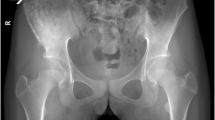Summary. Twenty-one patients with subacute osteomyelitis who were initially considered to have bone tumours were reviewed, with an average follow up of 3 years. The clinical symptoms were not specific and laboratory investigations were normal. The radiographic findings were limited osteolysis surrounded by bone sclerosis in 14 cases, osteolysis without definite borders in 6, and onion-layer periosteal bone formation in one. The preoperative diagnoses included osteoid osteoma, osteosarcoma, chondroblastoma, Ewing’s sarcoma, giant cell tumour, fibrosarcoma, eosinophilic granuloma, and bone tumour of unknown aetiology. The definitive diagnosis was made by surgical biopsy, histology and cultures which grew staphylococcus in 9 cases. The gross specimens all showed lymphocytes, plasma cells and granulation tissue with osteogenesis. All the patients recovered completely; 17 were treated with antibiotics and immobilisation, and 4 did not need an antibiotic. There was no recurrence of infection after curettage and excision of the infected tissues.
Résumé. Vingt et un patients atteint d’une ostéomyélite subaiguë
, considérée initialement comme une tumeur osseuse, ont été traités à l’hôpital Cochin et revus avec un recul moyen de 3 ans. La douleur, l’apyrexie, la normalité presque constante des résultats biologiques ne permettaient pas d’orienter le diagnostic. La radiographie mettait en évidence 14 fois une ostéolyse au sein d’une ostéocondensation, 6 fois une ostéolyse mal limitée et 1 fois une ossification périostée en “bulbe d’oignon”. Compte tenu de tous ces éléments, le diagnostic retenu avant l’intervention était 8 fois celui d’un ostéome ostéoîde, 3 fois celui d’un ostéosarcome, 5 fois celui d’une autre tumeur (un chondroblastome, un sarcome d’Ewing, une tumeur à cellules géantes, un fibrosarcome et un granulome éosinophile). Cinq fois un diagnostic de présomption tumorale a été retenu sans autre précision. Le diagnostic final a étéétabli par biopsie-curetage et examen bactériologique. Le germe le plus fréquemment retrouvéétait un staphylocoque doré (9 fois). L’examen histologique de la pièce opératoire montrait une infiltration lympho-plasmocytaire avec ostéogenèse. Ces 21 patients ont guéris avec une antibiothérapie adaptée et une immobilisation 17 fois. La guérison a été obtenue en l’absence d’antibiothérapie dans 4 cas.
Similar content being viewed by others
Author information
Authors and Affiliations
Additional information
Accepted: 21 May 1996
Rights and permissions
About this article
Cite this article
Cottias, P., Tomeno, B., Anract, P. et al. Subacute osteomyelitis presenting as a bone tumour . International Orthopaedics SICOT 21, 243–248 (1997). https://doi.org/10.1007/s002640050159
Issue Date:
DOI: https://doi.org/10.1007/s002640050159




